Experimentations 10: The Crystalline Entities
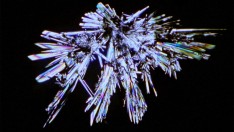
Last Things, by Deborah Stratman
Los Angeles Filmforum presents
Experimentations: Imag(in)ing Knowledge in Film, Program 10
The Crystalline Entities
Sunday December 8, 2024, 7:00pm
At 2220 Arts + Archives, 2220 Beverly Blvd. Los Angeles CA 90057
Conversation after the film with Andrew Kim and Deborah Stratman!
Crystals are inherently beautiful. They form our world; they are part of chemical-based photography that images it. They take innumerable forms, their growth is hypnotic, the light they scatter creates amazing colors. Many filmmakers have looked at crystals in myriad ways, and this program strives to capture an element of how the filmic investigation of one subject results in a brilliant array of filmic forms. From a well-crafted educational film from the 1950s to a mysterious experimental film and one that positions crystals in a post-humanist world, the program highlights the range of scientific visions and the experimental reuse or repositioning of those visions.
Curated by Adam Hyman
Tickets: $15 general, $10 students/seniors, free for Filmforum members
$20 for both programs today
Films include Crystals (Elwood Decker, 1951), Crystal Growth Morphologies (Kenneth Jackson and Charlie Miller, Bell Labs, 1974), Crystals (Richard Leacock, 1958), The Arctic (Wenting Zhu, 2019), The Vibrancy (Wenting Zhu, 2020), Instant Life (Andrew Kim and Ojoboca, 2022), Last Things (Deborah Stratman, 2023)
Experimentations: Imag(in)ing Knowledge in Film is Filmforum’s expansive film series and upcoming publication that investigates the ways that experimental and scientific films produce and question the visualization of the world. Combining artist films utilizing scientific imagery, science and natural history films, and films of indigenous and traditional knowledge, the series examines how science, nature, and technology films shape our understanding of humans, nature, gender, knowledge, and progress. The multi-venue public screening series presents analog and digital time-based media incorporating diverse scientific and experimental film traditions from across the globe. The series will include eighteen screenings between September 2024 and February 2025, with films and digital works from 1874 to today from around the world, multiple guests, panels and wonderful collaborations that will reveal the possibilities and circumstances of cinema in this realm.
Experimentations: Imag(in)ing Knowledge in Film is among more than 70 exhibitions and programs presented as part of PST ART. Returning in September 2024 with its latest edition, PST ART: Art & Science Collide, this landmark regional event explores the intersections of art and science, both past and present. PST ART is presented by Getty. For more information about PST ART: Art & Science Collide, please visit: pst.art.
Major support for Experimentations: Imag(in)ing Knowledge in Film is provided by the Getty Foundation and The Andy Warhol Foundation for the Visual Arts. Additional Support from the Los Angeles County Board of Supervisors through the Los Angeles County Department of Arts & Culture, and the Department of Cultural Affairs, City of Los Angeles.
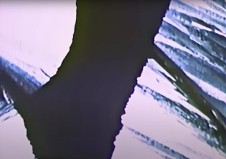
Crystal Growth Morphologies
Crystal Growth Morphologies
By Kenneth Jackson and Charlie Miller, Bell Labs
1974, color, silent, 10:43
Footage Courtesy of AT&T Archives and History Center, Warren, NJ
This short, silent film shows fascinating crystal growth under magnification, in real-time. The width of the film frame, for most of the samples, is only 1mm wide (only one, the Tristearin sample, is 1/4 of that). Kenneth Jackson and Charlie Miller were the Bell Labs researchers who made the film to document their work. This film was leased during the 1970s and 1980s for audiences of university students, to complement relevant classwork.
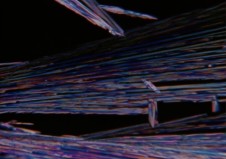
Crystals
Crystals
By Elwood Decker
1951, Color, silent, 2:15
Print courtesy of the Academy Film Archive
Elwood Decker (1902-1992) was an American painter who also made a few short films. This film emphasized very brilliant colors. Some of the crystals were thin and elongated, almost like needles. Others looked like snowflakes growing. The growing crystals were seen through translucent abstract forms, which drifted over and through them, like ghosts. This was achieved by a making a series of double exposures on the same film print. In his journal he wrote, '...Like the Dunes, the simplicity of crystals make them seem like moving abstraction... ideas, rather than things...'
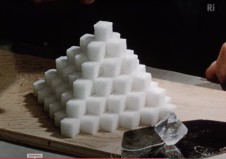
Crystals
Crystals
By Richard Leacock
1958, 16mm transferred to digital, color, sound, 24:30
This color film from 1958 and made by the Physical Science Study Committee shows Alan Holden from the Bell Laboratories explaining how crystals are formed and why they are shaped the way they are. The film goes on to show crystals growing while under a microscope. Blue Ribbon winner, American Film Festival.
Ricky Leacock (1921-2011) was a major documentary maker, generally in the direct cinema mode. His most well-known film is probably CRISIS (1963), but he was also cinematographer on Robert Flaherty’s LOUISIANA STORY (1946), one the cameramen on MONTEREY POP (1967), and formed Leacock Pennebaker Inc. with D.A. Pennebaker in 1963, making multiple filsms in the 1960s and 70s. In 1969, he was appointed Professor of Cinema at Massachusetts Institute of Technology. CRYSTALS is one of five films Leacock made for the Physical Science Study Committee Physics series. https://www.afana.org/leacock.htm
Alan Holden (1904-1985) was a physicist who helped to develop sonar equipment used to detect submarines during World War II. Born in New York City, went to work for the Bell Laboratories Division of the American Telephone and Telegraph Corporation in N.J., after receiving his bachelor's degree from Harvard in physics and mathematics in 1925. Later, in 1935, he joined the research staff where he worked as a physicist until retiring in 1960. During World War II, he helped to develop methods for producing the large crystals that form the heart of the sonar equipment used by the United States Navy to locate enemy submarines. The Physical Science Study Committee (PSSC), made up of a group of MIT scientists, created a series of films in the late 1950s and early 1960s aimed at teaching the physical sciences.
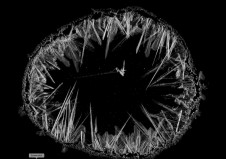
The Arctic
The Arctic
By Wenting Zhu / Beauty of Science
China, 2019, digital, color, sound, 2:44
THE ARCTIC began in October 2018 and lasted approximately seven months. It documents the crystallization processes of various salts. As supersaturated solutions evaporate, crystals form, each substance creating unique crystalline structures. Most of the footage was captured through time-lapse photography, showcasing the diverse growth patterns of the crystals and their transformations throughout the crystallization process.
The title of this film draws inspiration from the icy beauty of the Arctic, much like the delicate and ephemeral crystals depicted in the film, which echo the fragility of the vanishing Arctic. The film aims to inspire viewers to marvel at the wonders of the ice world and reflect on the importance of protecting our planet.
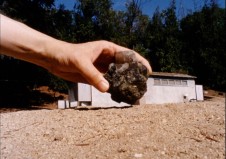
Instant Life
Instant Life
By Andrew Kim and Ojoboca
2022, 16mm, color, sound, 27 min.
Ludwig Faces produced, directed, shot and edited the film Instant Life (1941).1 On the occasions when he screened the film for an audience, he stated, vehemently, that the film should be understood, principally, as a solution to the problem of moving picture spectatorship.2
After each screening of his film, Faces would hand out a small sheet of colored paper to every member of the audience. On each sheet there was a typewritten riddle. He did not provide an answer to the riddle, nor did he ask for one. Descriptions of the evening’s events come from three filmmakers who were present for three separate screenings.3 Not long after attending the third screening, they began to call themselves The Unholy Three.4
Upon leaving the back room of the laundromat that had served as the evening’s cinema on their third and last viewing, The Unholy Three decided that they had to put aside all of their other projects and dedicate their time solely to cracking the riddle. After a few months they felt they had arrived at an answer. They did not reveal their answer to anyone.5
Shortly after, in the fall of 1979, they began production on a film, also titled Instant Life. Their film, which was originally conceived as a shot-for-shot remake of Faces’ film, eventually became three separate shot-for-shot remakes of Instant Life (1941).6 Upon completing the three versions, they decided that all three should be shown sequentially as a single film.
The three films you will see are shot-for-shot reproductions of the compilation film Instant Life (1981). Each film in Instant Life (1981) was a remake of an earlier film also called Instant Life (1941). The earlier Instant Life (1941) was a single film, not a compilation.
In 2017, we decided to recreate Instant Life (1981). We did not attempt to recreate Instant Life (1941) because that Instant Life is lost. Instant Life (1941) was a silent film presented with live musical accompaniment. After the show, audience members received a printed riddle. Instant Life (1981) is a sound film. The riddle is part of the film. No answer to the riddle exists.
Andrew Kim is a filmmaker based in Los Angeles, CA. His films have screened at a variety of venues and festivals including the Ann Arbor Film Festival, International Film Festival Rotterdam, Images Festival, BAFICI, UnionDocs, and Los Angeles Filmforum, among others. He teaches filmmaking at the California Institute of the Arts and helped manage the Echo Park Film Center, a non-profit media arts center.
Anja Dornieden and Juan David González Monroy are filmmakers based in Berlin. They work together under the moniker OJOBOCA. Together they practice Orrorism, a simulated method of inner and outer transformation. They have presented their films and performances in a wide variety of venues and festivals worldwide, among them the Wexner Center for the Arts, Österreichische Filmmuseum, Anthology Film Archives, Haus der Kulturen der Welt, Kunstverein München, Ullens Center for Contemporary Art, International Film Festival Rotterdam, Berlinale, New York Film Festival, Visions du Réel, RIDM, Ann Arbor Film Festival and Edinburgh International Film Festival. Both González Monroy and Dornieden are members of the artist-run film lab LaborBerlin.
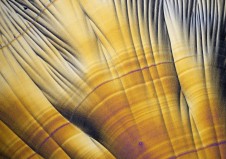
The Vibrancy
The Vibrancy
By Wenting Zhu / Beauty of Science
China, 2020, digital, color, sound, 2:39
Microscopy expands our perception and imagination of the world, allowing us to witness beauty in many different forms.
THE VIBRANCY uses polarized light microscopy to capture the fascinating crystallization processes of various substances. The artist explores the creative potential of nature by combining different organic solutions, creating painterly crystalline images under the microscope. Droplets of organic solution spread across a 5-centimeter glass surface, with crystals slowly forming over time. Through the polarized light microscope, the crystals resemble flowers blooming and plants growing in the darkness, revealing a marvelous scene brimming with vibrant life energy.
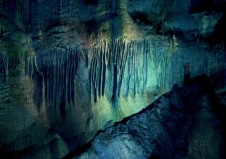
Last Things
Last Things
By Deborah Stratman
2023, 35mm to digital, color, sound, 50 min.
What happens to us / Is irrelevant to the world’s geology / But what happens to the world’s geology / is not irrelevant to us. -Hugh MacDiarmid
Last Things looks at evolution and extinction from the perspective of the rocks and minerals that came before humanity and will outlast us. With scientists and thinkers like Lynn Margulis and Marcia Bjørnerud as guides and quoting from the proto-Sci-fi texts of J.H. Rosny, Deborah Stratman offers a stunning array of images, from microscopic forms to vast landscapes, and seeks a picture of evolution without humans at the center.
